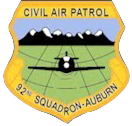
Growing from its World War II experience, the Civil Air Patrol has continued to save lives and alleviate human suffering through a myriad of emergency-services and operational missions.
Search and Rescue : Perhaps best known for its search-and-rescue efforts, CAP flies more than 85 percent of all federal inland search-and-rescue missions directed bybthe Air Force Rescue Coordination Center at Tyndall Air Force Base, Fl. Outside the continental United States, CAP supports the Joint Rescue Coordination Centers in Alask
a, Hawaii and Puerto Rico. Just how effective are the CAP missions? Approximately 75-100 people are saved each year by CAP members.

Disaster Relief : Another important service CAP performs is disaster-relief operations. CAP provides air and ground transportation and an extensive communications network. Volunteer members fly disaster-relief officials to remote locations and provide manpower and leadership to local, state and national disaster-relief organizations. CAP has formal agreements with many government and humanitarian relief agencies including the American Red Cross, Federal Emergency Management Agency, Federal Aviation Administration, National Transportation Safety Board and the U.S. Coast Guard.

Air Force Support : It’s hardly surprising that CAP performs several missions in direct support of the U.S. Air Force. Specifically, CAP conducts light transport, communications support, and low-altitude route surveys. CAP also provides orientation flights for AFROTC cadets. Joint U.S. Air Force and CAP search-and-rescue exercises provide realistic training for missions.

Counterdrug : CAP joined the “war on drugs” in 1986 when, pursuant to congressional authorization, CAP signed an agreement with the U.S. Air Force and U.S. Customs Service offering CAPresources to help stem the flow of drugs into and within the United States.





